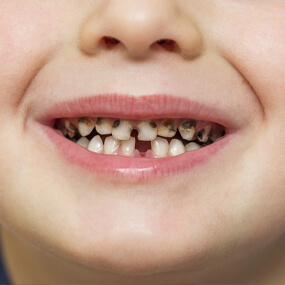The Pros and Cons of Porcelain Veneers and Dental Bonding

Cosmetic dentistry is a broad area of dentistry that encompasses many different cosmetic procedures as well as preventive and restorative dental treatments. The emphasis of this field is smile enhancement, and porcelain veneers and dental bonding are two techniques often used to achieve that.
Porcelain Veneers
A veneer is a type of dental overlay that covers the visible aspect of a tooth. There is no need to cover the backside or the biting surface because the focus here is on appearance. Porcelain is not the only material used to make veneers, but it is a popular option due to how natural it looks. Often, veneers are placed in sets of a six or eight in order to transform a smile, and your dentist can dictate the color, size, shape, and other characteristics so that your veneers blend perfectly with your other teeth.
What Does the Porcelain Veneer Process Entail?
Getting dental veneers generally requires two visits to your dentist. There may be additional visits depending on your unique needs, but here, we will focus on the two required visits.
First Visit
The first visit is necessary to prepare the teeth that will be covered. The prep involves removing enamel and shaping the tooth so that the veneer sits perfectly without adding girth to the natural tooth. Many patients do not require an anesthetic, but it is available for those who do. Once the teeth are prepared, your dentist will take high-definition three-dimensional images of the teeth. These images are then transferred to a computer system through which your dentist can design your custom veneers.
Veneers must generally be manufactured at a dental laboratory. Once your dentist has designed your veneers, he will transmit this data to the lab. Your dentist will then place temporary veneers that look nice and will last until it is time to come back and have the porcelain veneer placed. Temporary veneers do require some specific maintenance, and your dentist will give you those instructions.
Second Visit
Your second visit will be scheduled about three weeks after the first. Your dentist will remove the temporary veneers, clean the teeth, and then place the porcelain veneers. Your dentist will adjust them to position them just right and seek your approval as well. Once you are happy, your dentist will apply a dental cement that will bond the porcelain veneer to your natural tooth.
Dental issues porcelain veneers can fix include:
- Discoloration
- Misshapen teeth
- Undersized teeth
- Teeth with gaps
- Uneven or rotated teeth
Dental issues porcelain veneers cannot fix include:
- Tooth decay
- Missing teeth
- Gum disease
- Receding gums
- Loose teeth
Dental Bonding
The term dental bonding refers to using a tooth-colored resin material to improve the aesthetics of a tooth. This composite material can create a strong bond with your tooth enamel, and your dentist can use it to fill cavities as well as adjust the form of visible teeth for an improved appearance. The composite can be made in practically any color, and your dentist can adjust that color based on the natural shade of your teeth. Since the material bonds with the tooth, there is no need to prepare the tooth as with a veneer, and your dentist can polish it so that the line between the tooth and material is imperceptible.
What Does the Dental Bonding Process Entail?
Placing dental bonding requires just a single visit, but as with porcelain veneers, your unique circumstances may demand additional visits. Prior to placing the bonding, your dentist may perform some prep, like reshaping any aspects of the tooth that cannot be corrected with the resin, such as a bulging area. Your dentist will then place the resin, shape it as needed, and then polish it to perfection. How long the process takes depends on the number of teeth and the extent of the correction. Dental bonding is not as strong as enamel, and so care must be taken to avoid damage, and your dentist will provide you instructions on how to care for the bonding at home.
Dental issues bonding can fix include:
- Chipped front teeth
- Cracked front teeth
- Small gaps between teeth
- Defects in tooth enamel
- Discoloration in small areas
Dental issues bonding cannot fix include:
- Loose teeth
- Missing teeth
- Crooked teeth
- Large cavities
- Receding gums
- Gum disease
- Dark discoloration
- Large areas of discoloration
Other Notable Differences Between Veneers and Bonding
- Dental bonding is less expensive than porcelain veneers.
- Bonding can correct specific issues, whereas veneers can be used for a smile makeover.
- Bonding is often used to make small changes. Veneers can be used to make big changes.
- Bonding is reparable but more likely to chip or otherwise be damaged.
- Porcelain veneers are not repairable but less likely to chip or otherwise be damaged.
- Dental bonding is effective as a quick fix for those minor problems.
- Porcelain veneers are not as quick but can transform your appearance and confidence.
And the Verdict Is…
It depends. You may have an idea of which treatment is a better fit for you based on the information provided here. However, the only way to truly know is to schedule a consultation with your dentist, ask questions, discuss the options, explore the pros and cons, and so forth. There are aspects to your choice that you may not have considered yet but are very relevant to your particular situation.
Often, it comes down to what you are seeking to achieve and how much you are willing to spend. If the work you want to be done is not covered by insurance and you are seeking the most cost-effective solution, then dental bonding is likely a great choice. If, on the other hand, you want to prioritize aesthetics and paying more for a natural and durable solution is viable, then porcelain veneers are a great choice. Whatever you decide, the result will be effective, attractive, and well worth the investment.
Beautify Your Smile
Jeffrey D. Clark, DDS, is a premier cosmetic dentist serving the Greater Scottsdale area. Dr. Clark has more than 20 years of experience helping people perfect their smiles with porcelain veneers, dental bonding, and other treatment options. You can meet with Dr. Clark to have your teeth assessed and to explore the various cosmetic procedures available to you. Call Scottsdale Cosmetic Dentistry Excellence at 480 585 1853 for more information about any cosmetic procedures and to schedule your appointment.




